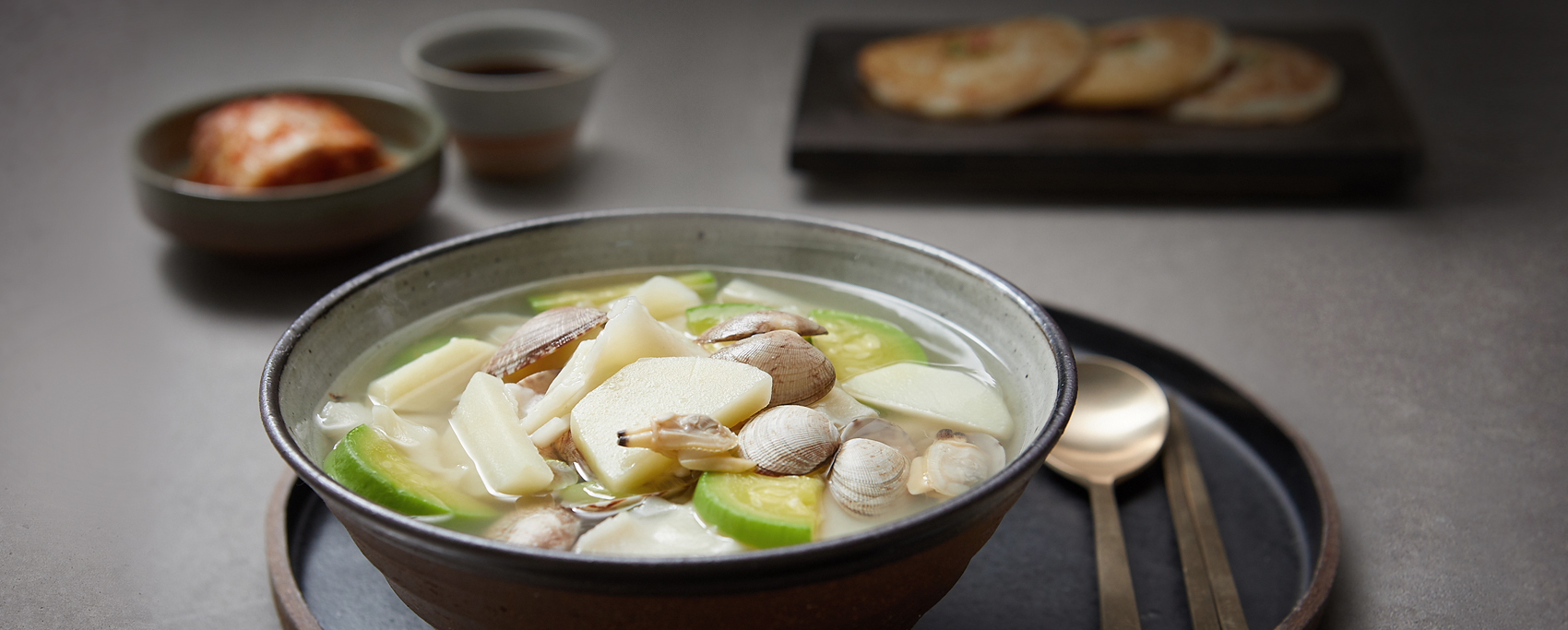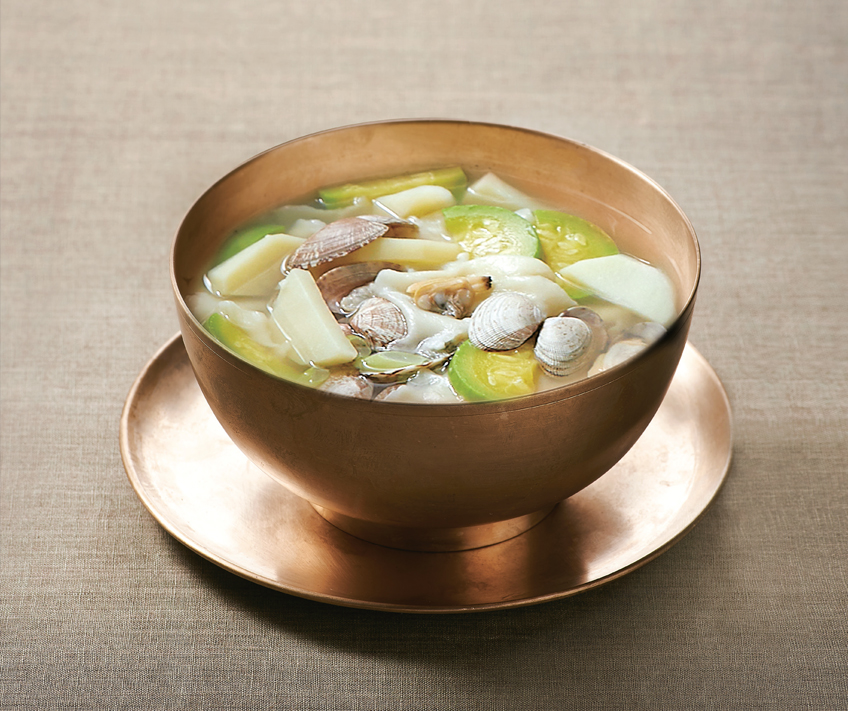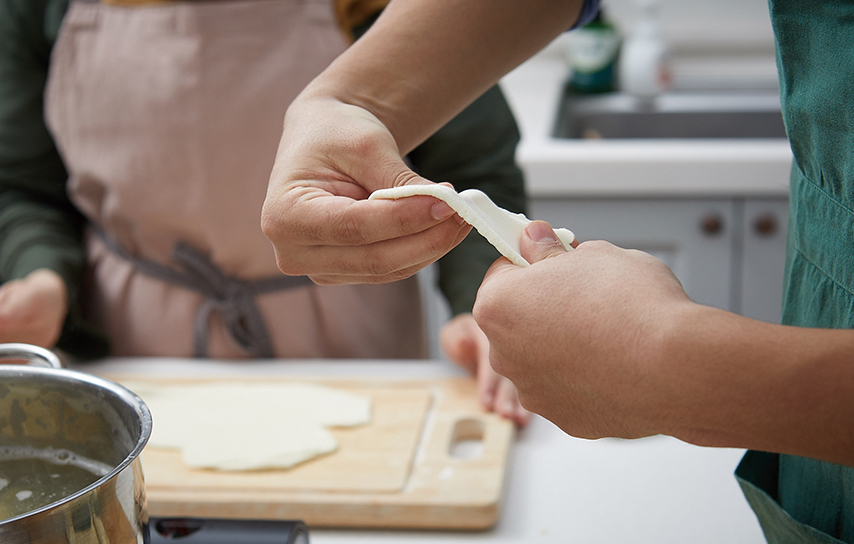
Contents





Love Travels Through the Strings of the Violin






Sujebi
A Spirit of Sharing
From a luxurious food only available to the rich to an ordinary food for everyone, sujebi hand-pulled dough soup has become one of the most popular comfort foods on rainy days. Rustic pasta in a bowl of hot briny broth warms one’s body and soul. When it gets chilly and you need some warmth around you, there is nothing better than sharing a meal from a common pot with your loved ones.
Written by Lee Hwa-jeong Photographed by Studio Kenn

Sujebi Hand-Pulled Dough Soup,
Food for All
The word sujebi comes from the words “su” and “jeobi,” meaning “hands” and “to fold,” which was developed into today’s word sujebi. This makes sense when you look at how the food is made, where the core ingredient is handmade noodles. The rustic pasta pulled by your hands, makes not only the taste better, but cooking more fun and dynamic.
Since wheat flour was hard to get for commoners back in the olden days, sujebi was only served on special occasions, like banquets or birthdays. However, as flour became more common, sujebi is now an ordinary food for everyone. In fact, it’s one of the easiest and fastest foods you can make at home. A lot of variations can be found, depending on the region. While flour is most commonly used for the dough, other locally grown ingredients, such as potatoes, buckwheat or acorns, have also been adopted in different parts of Korea.
This hearty and wholesome comfort food will help beat the cold and warm you up when it gets chilly outside, as the fall winds down into winter. Enjoying the various textures in a bowl of hot broth is truly a food for the soul.
Bringing It Back Home
“When I first came to Korea in 2013, I regretted not having been able to learn more about Korean culture. However, this time, I promised myself that I would bring home something valuable from Korea and share it with my family and community. I know food is a great way to do that, so I’m very excited.” Mahmood and Wejdan are a husband-wife pair from Jordan. Since they rarely had the chance to learn or cook Korean food, they were excited to learn more about Korean cuisine, which they believe will help them get closer to Korean culture.
They found it interesting that, while living in Korea, they could always see things that were similar to their own society. The concept of eating a meal from a common pot in the middle of the table is one of them. Sujebi is a good food to be shared, all eaten together from the common pot, just as are many foods in Jordanian cuisine.

Meticulous Care for a Core
Ingredient
The first thing we did was to mix flour, salt and water and let it sit for half an hour to make pasta dough. This process gives a nice texture to the pasta and makes it a bit chewier. For the broth, we used dried anchovies and kombu. If you want to make your soup completely vegan, you can simply use kombu instead of some other seafood base. First, cook the anchovies a little until the moisture is gone. Then add cold water and the kombu to the same pot. Since these first steps determine the taste of the broth, meticulous care is required in this process. “This broth is actually used as a base for many types of Korean foods,” the instructor explains. “If you have this on-hand, you’re 50 percent ready to make any Korean soup.” When it comes to boiling, turn it down to simmer it on the lowest setting for another 10 minutes or so. While waiting for the perfect broth, we prepared the other ingredients. The main ingredients are easy to get anywhere. They include potatoes, zucchini and green onions. Depending on one’s taste, you can either blend the potatoes or cut them in big chunks. We chose to make big cubes this time, since it’s more fun to eat.
When the pasta dough was finally ready, we grabbed a ball of dough and rolled it to flatten it. Wejdan and Mahmood competed with each other, wildly tearing off pieces of dough, laughing together. “I think even our 1-year-old daughter, Alma, would enjoy making these dough balls.” These paper thin disc pastas were dropped directly into the boiling broth that was simmered and ready. When all the ingredients are finally in the pot, green onions and zucchini were added at the end, since you don’t want them to get too mushy. For seasoning, add a pinch of salt or soy sauce to your liking. When the noodles float to the top, that means it’s ready to be served.
 Tearing off the dough is a fun way to make a rustic pasta.
Tearing off the dough is a fun way to make a rustic pasta.
Wejdan and Mahmood take an overflowing spoonful, brimming with all the ingredients in the soup. “The combination of chewy pasta, potato and crunchy veggies is so amazing,” adds Wejdan. She really liked the harmonious texture of the ingredients. “The broth is so unique. It’s got a deep taste that is perfectly briny.” Mahmood also adds after he takes one bite. Both were happy with their first attempt at cooking Korean food and are excited to make it for their family when they get back home.
Good food has a way of bringing families together. Regardless of where we are from, we seem to agree on the value of spending time with our family. Sikgu is family in Korean, which is literally translated as members who share meals and live together. This shows how much it means to have meals together as a family. In the hectic lives we live these days, this feels even more precious. Bring a sujebi recipe home, and you will appreciate the spirit of sharing with your loved ones.
Cooking Tips
Ingredients
2 potatoes, 0.33 zucchini, 0.5 stalk green onion, 20 dried anchovies, 1 slice of kombu, 1 liter water, 2 tablespoons of soy sauce, a pinch of salt (150 grams of clams can be added to the broth additionally)
Ingredients for noodles
2 cups of flour, 1 to 1.25 cups of water, a pinch of salt

Other Articles





Love Travels Through the Strings of the Violin





Application of subscription
Sign upReaders’ Comments
GoThe event winners
Go


 October 2018
October 2018


